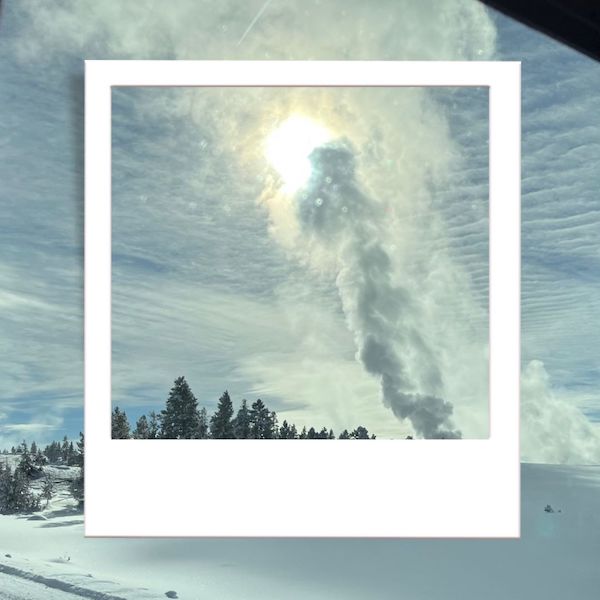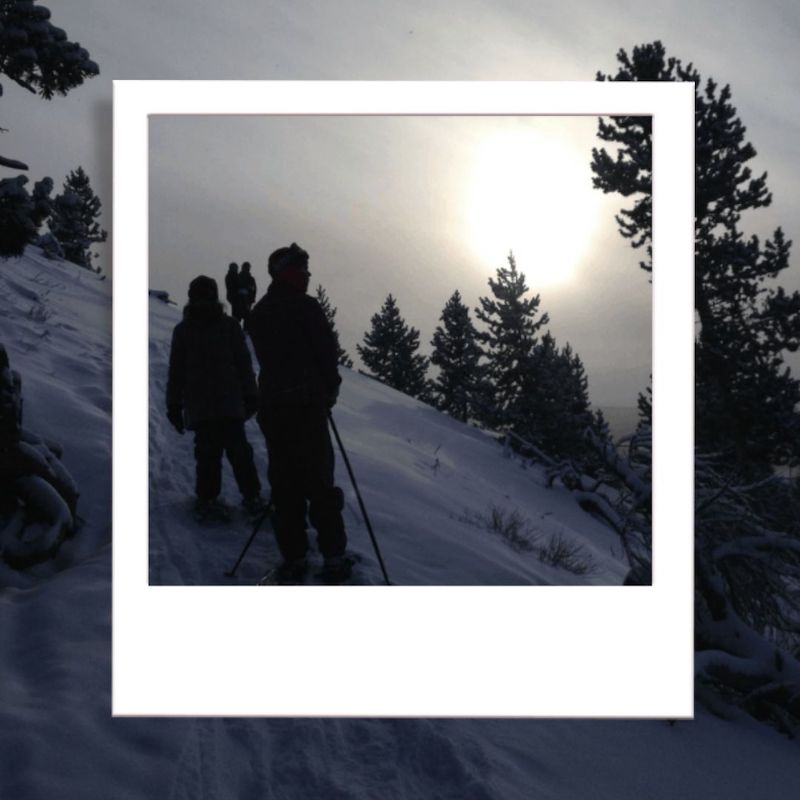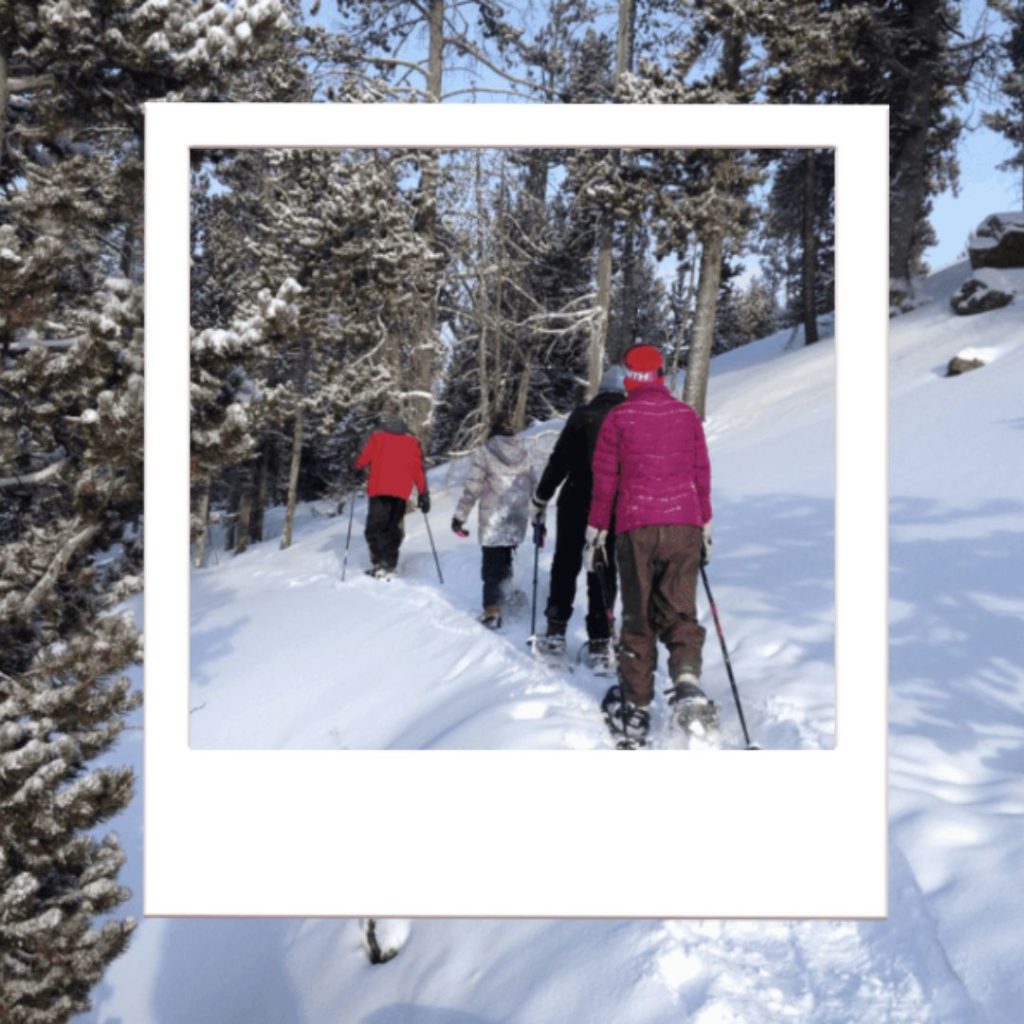
Yellowstone in winter is an adventure in comparatives. It’s more majestic and less crowded than in other seasons. It’s more difficult to get around. (Even the animals take the road.) It’s also more difficult to do simple and necessary tasks. (Consider a visit to an unheated vault “comfort station” at nineteen degrees below zero.) There are fewer places to go and just two places to stay. Even so, there’s a lot to do and plenty to think about when it comes to planning a winter’s visit.
What is there to do?
- Snowshoe or cross-country ski: Snowshoes are available for rent in the park, as are cross-country skis and lessons for beginners. I’ve done both and prefer snowshoeing. We often take trails that we can reach from the road or our lodging: Observation Point above Old Faithful, the Upper Geyser Basin, the Upper Terrace at Mammoth Hot Springs, and the confluence of the Yellowstone and Lamar Rivers.
- Drive the open road: This will take you through the Lamar Valley, sometimes called the American Serengeti because of its abundant and varied wildlife. One winter’s day drive brought us within good viewing distance of bison, elk, bighorn sheep, and even two wolves feasting on an elk carcass. The road will take you over the Yellowstone River, along the Lamar River, Soda Butte Creek, and Ice Box Canyon, and to the foot of Barronette Peak.
- Tour the park via snowmobile or snow coach: Yellowstone has strict winter use policies. Snowmobilers require a guide. Snow coach drivers love the park and give good tours.
- Ice skate: Both the Mammoth Hot Springs hotel and the Old Faithful Snow Lodge have outdoor skating rinks for their guests to use, as well as skates in all sizes. They are lit, well-maintained, sheltered from the wind, and have an inviting fire in the evenings. Even if you aren’t a skater, it’s worth going out to sit for a few moments by the fire.
- Take a walk: Explore Mammoth Hot Spring’s Lower Terrace. Meander through the Mammoth Hot Springs buildings. Walk along the historic Officer’s Row, named for the homes which housed army officers when the Mammoth area was Fort Yellowstone. The Old Faithful Area has walkable paths between the Snow Lodge and its cabins, the Visitors Center, and the Old Faithful boardwalk. You can watch Old Faithful erupt from the boardwalk or the warmth of the Visitors Center.
- Nothing Really. The Mammoth Hot Springs Hotel lobby has chairs drawn up cozily around a fire. Its Map Room, named for the grand inlaid map of the United States, has a wall of windows and a gracious bay, a lending library for games and books, and comfortable seating to enjoy it all. This–and the Snow Lodge’s chair-lined fire, game tables, and snug seating areas–are great spaces to spend an hour, an evening, or even a day reading and thinking or watching the humanity around you.

What might I see?
- So much white (anchored by pine green and colorful pools): It’s simultaneously fascinating and soothing.
- Wildlife: Bald eagles, swans, otters, frost-covered bison, wolves, and elk are all active in the winter.
- Hoar frost: Formed by a meteorological phenomenon, hoar frost builds up in thick layers in places where there are pockets of warm air—in the geyser basins, on the bison, on the trees. I find it lovely.
- Diamond Dust: A ground cloud of tiny ice crystals, it’s a rare delight.
- Things you might not notice in other seasons: Against all that white, other things are more noticeable.
What should I expect in the winter?
- Extreme cold: Typical daytime temps range between zero and 20 degrees. It could be warmer and it will often be colder—below zero colder. If you’re dressed for the weather, it’s quite tolerable—pleasant even. It’s just important to realize how cold winter in Yellowstone is. It’s also key to understand that it’s a dry cold–as opposed to the humid variety found in other parts of the US. That means that, if the wind isn’t blowing, low temperatures don’t feel as dangerously cold as they are. The threat of frostbite and hypothermia are real. Read about our family polar vortex Yellowstone adventure here.
- A reprieve: Even with the extreme cold, winter in Yellowstone soothes the senses. There’s less contrast and less noise. My dad says that Yellowstone’s winter silence almost sucks the sound out of your head. You don’t have to get far from a building or your vehicle to hear the silence, but you do have to stop. Shoes, skis, and snowshoes squeak on the snow.
- To need alternative transportation: Of Yellowstone’s few hundred miles of paved road, only the scenic and worthwhile fifty-two mile stretch between the North and Northeast entrances is open to wheeled vehicles in the winter. All other roads are closed or open to snowmobiles or snow coaches only.
- A short season: While the park is open year-round, the roads, hotels, gas stations, and most restaurants are not. Winter season runs from late December through early March.
- Few people: Not many people visit Yellowstone in the winter.

How do I prepare for a winter trip?
- Pack for extreme winter weather: Our last winter visit was during a polar vortex. It was intense, but still worth it. Winter may be the easiest season to pack for because it’s the only one that doesn’t require clothes for all possible weather. Pack all the warm outerwear. Add base layer items. Bring your favorite sweaters.
- Research and reserve transportation and in-park accommodations early: There’s not a lot of anything in the winter—hotel rooms, snowmobiles, snow coach seats. Better to plan ahead than be disappointed.
- Consider food: You will, of course, need to eat. There is a fast food and finer dining establishment open at both the Mammoth and Old Faithful areas but you may find yourself out snowshoeing, waiting for a geyser to erupt, in a snow coach, or in in the middle of the park on a snowmobile at mealtime. It’s important to think through sustenance before you go. There are no grocery stores open in the park in the winter.
- Leave a little cushion in your arrival and departure plans: Not only might you encounter weather-related delays on your way to the park, you may also encounter them once you’ve arrived. Even within the park, the National Park Service sometimes closes roads to during extreme weather.
happy trails ~ Natalie 🥾
Encountering God in Yellowstone
In the landscape of everyday life, it’s easy to succumb to the idea that I can do it–whatever it might be–on my own. With its extreme weather, Yellowstone is quick to remind me that I’m only human, with human frailties and limitations. Out in the winter wilderness, without snow-shoes or skis or properly maintained roads for snowmobiles or snow coaches, I’d be stuck. Without shelter or even proper outerwear I would freeze. It can take a long time for me to get to the end of myself in everyday life. Yellowstone helps me remember that my weakness isn’t a liability, it’s a vehicle for God’s strength.
Additional Resources
- For more information about planning a trip to Yellowstone, check out the National Park Service website here.
Let’s go to Yellowstone! shares posts at these linkups.